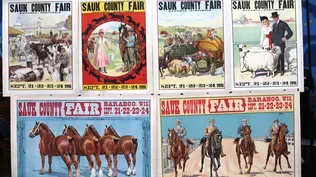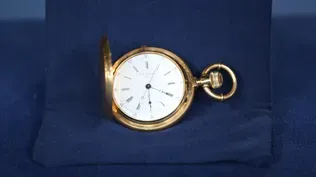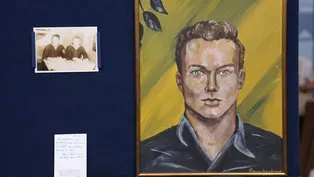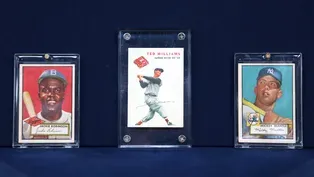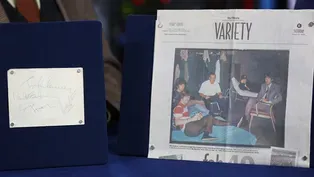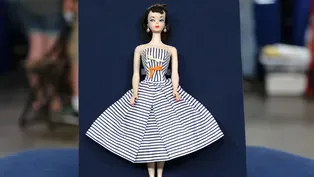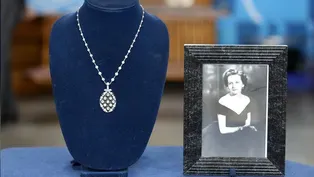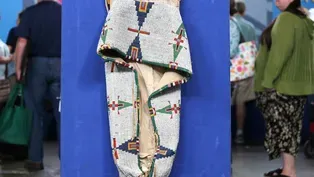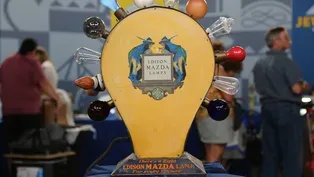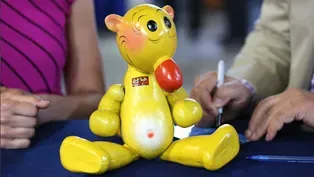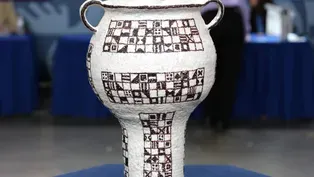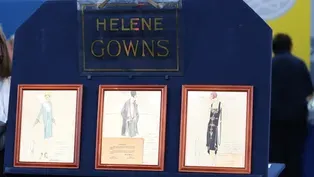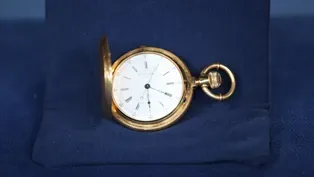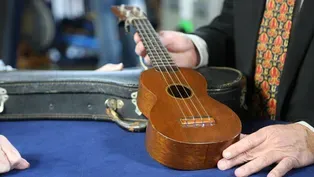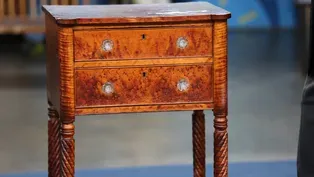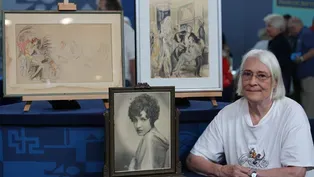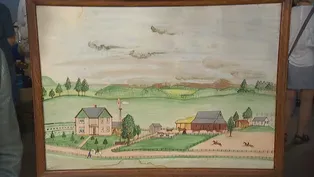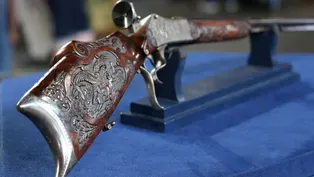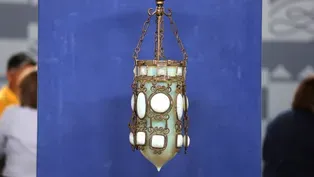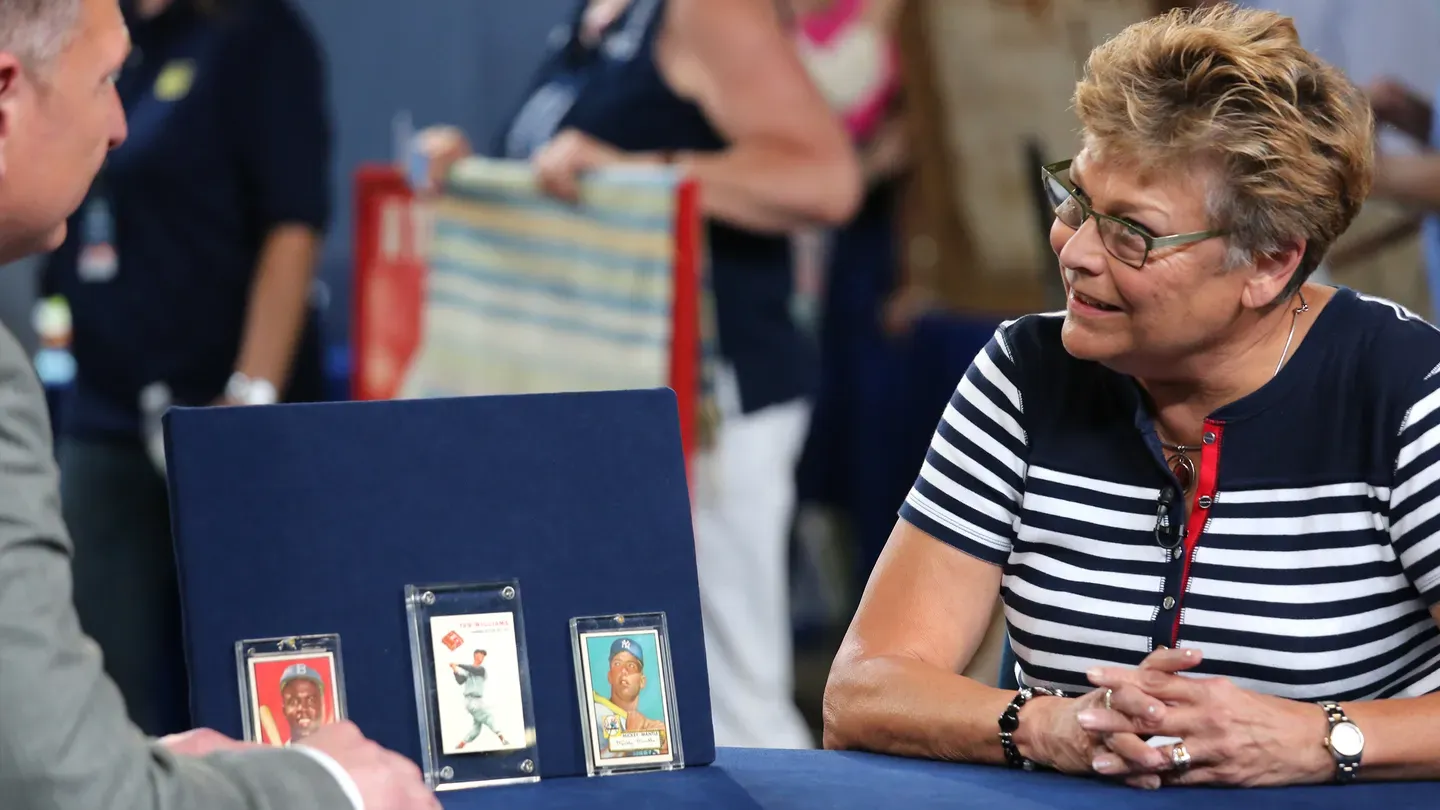

Green Bay, Hour 3
Season 22 Episode 15 | 52m 31sVideo has Closed Captions
A Belle Epoque diamond necklace, 1952 & 1954 baseball cards, and a Cheyenne cradleboard!
Discover Green Bay treasures with ANTIQUES ROADSHOW including a Belle Epoque diamond necklace from about 1915, 1952 & 1954 baseball cards, and a Cheyenne cradleboard made around 1895. Watch to learn which is the top find of the hour!
Problems with Closed Captions? Closed Captioning Feedback
Problems with Closed Captions? Closed Captioning Feedback
Funding for ANTIQUES ROADSHOW is provided by Ancestry and American Cruise Lines. Additional funding is provided by public television viewers.

Green Bay, Hour 3
Season 22 Episode 15 | 52m 31sVideo has Closed Captions
Discover Green Bay treasures with ANTIQUES ROADSHOW including a Belle Epoque diamond necklace from about 1915, 1952 & 1954 baseball cards, and a Cheyenne cradleboard made around 1895. Watch to learn which is the top find of the hour!
Problems with Closed Captions? Closed Captioning Feedback
How to Watch Antiques Roadshow
Antiques Roadshow is available to stream on pbs.org and the free PBS App, available on iPhone, Apple TV, Android TV, Android smartphones, Amazon Fire TV, Amazon Fire Tablet, Roku, Samsung Smart TV, and Vizio.
Buy Now

ANTIQUES ROADSHOW 2025 Tour!
Enter now for a chance to win free tickets to ANTIQUES ROADSHOW's 2025 Tour! Plus, see which cities we're headed to!Providing Support for PBS.org
Learn Moreabout PBS online sponsorshipMARK WALBERG: "Antiques Roadshow" is unearthing the treasures of Green Bay, Wisconsin.
WOMAN: The sign they dug out of the chicken coop where they stored a lot of stuff, so...
It was one of those things that was kind of always in my family, but I never really liked.
(laughs) ♪ ♪ WALBERG: "Roadshow" visited the Oneida Nation Museum to admire an array of artwork created by Native American tribal artists.
In the first half of the 19th century, groups of Oneidas migrated from New York to what would become the State of Wisconsin, and brought with them the tradition of corn husk dolls.
In Oneida culture, these faceless dolls traditionally symbolize humility and teach responsibility.
Back at the Roadshow, another Native American item made for children turned up in front of our cameras.
Take a look.
MAN: My father traded a service to the Winnebagos who lived next to us, and we traded the service, they gave him this.
They worked on our farm, they lived around us, we went to their powwows when I was younger.
We were a closely knit little community, a rural community.
Okay.
But we have equipment there-- he must have fixed something for them.
He must have done something that was very much appreciated because this is a significant object.
It's quite interesting.
Can you tell us when you, when it came into your possession?
My understanding, it was the late '50s, early '60s.
So you've had it 60, 65 years.
It's been around the family.
Winnebago, you thought.
That's who gave it to us.
Okay, it's actually Cheyenne.
Cheyenne Indians from the Great Plains.
They're really well-known for their decorated cradleboards.
And this cradleboard is gigantic.
It is.
I measured it.
It's roughly four-and-a-half feet-- it's really big.
These are called skis.
They're typically decorated with brass tacks.
In this case, they're steel.
And that's an indication that maybe it's a little bit later than the height of this tradition.
The most famous of these and the most fully developed, maybe in, more or less in the 1870s.
Oh.
My sense of this is it's a little bit later-- 1890, possibly as late as 1900.
The beadwork is classic Cheyenne design.
In 1870, these beads would have been stitched with sinew, animal sinew.
Yep.
These are stitched with cotton thread.
There are elements of Native tanned hide, but most of the backing and most of the foundation is canvas.
So that would be a trade item rather than deer hide from an earlier period.
But the designs are classic Cheyenne that carried over from the mid-19th century to the end of the century.
So the lady who made this is very much honoring ancient traditions, ancient design symbols.
This is meant to protect a baby.
Yes.
So this big hood, which should come all the way up like this, would protect the child from sunlight.
If it fell, this would catch the ground and protect the head.
It's a little bit tired in terms of condition.
The cotton string has broken down a little bit, some of the beads are missing, it's a little bit dirty, it's a little stiff in spots.
All of that can be remedied.
These are very desirable.
It's a little bit late, it needs a little bit of help, but I think on a retail basis today, this would sell for $25,000 to $30,000.
And the person who acquired it, I think, would be thrilled to own it.
(laughs) My... For not too, too much money, given that value, it could be restored, and you could add another 20% of value.
Maybe get it up to $35,000, $40,000.
Fantastic.
(chuckles) Dad would have never thought that.
MAN: I don't know too much about it, but I got it from my father about three years ago.
He gave it to my wife and I as a housewarming present.
He's had it in his house for a number of years, and he knew I liked it.
APPRAISER: And do you know where he got it originally?
I believe he bought it in the late '70s.
He said he bought it just at a local auction.
I asked him, actually, how much he paid for it, since I was coming to the "Antique Roadshow," and he said he thought $75, but he couldn't remember.
(chuckles) Okay, I like that.
Well, it's a wonderful item.
What we have here is a store display for Edison Mazda bulbs.
So Mazda was the name of the bulb, was the name of the line of bulbs that Edison had developed.
And you can even see Mazda on some of the sides of these bulbs.
And this whole thing was, at the time, a G.E.
company.
So this would have been something that you would have had at a shop, and they would have put any number of different bulbs on here.
These ones you have here, a lot of them are original Mazdas, but there's no rhyme or reason to which ones they put on.
It's a litho-printed metal surface.
It's got this wonderful illustration here by Maxfield Parrish.
So Maxfield Parrish was a very famous, very influential artist in the early 20th century.
He had a career for over 50 years.
Norman Rockwell considered him his idol, so he was quite a talented guy.
And we can even see in the print here, it says, "M.P.," for Maxfield Parrish.
And then of course you've got a great artist combining with a great American genius, Thomas Edison.
Each different light bulb even has some unique features to them, as well.
And what's interesting about this is, you can turn each of them off at a time because there's a switch by each socket.
So you'd plug it in, you could turn on or turn off whatever light bulbs you wanted.
Date-wise, this would have been in the 1920s, maybe late part of the '20s, maybe early '30s.
Right around when Parrish was kind of at his height.
Now, do you ever plug it in at home or... No, I've never plugged it in.
I mean, the cord's pretty old, and I'd be afraid of what happens, so... (laughs): I don't blame you.
I'd love to try it, but we don't want to damage it.
Condition's not bad.
You've got some wear.
It's probably been out for a while.
May even be a screw loose here or there.
All that said, I would think conservatively, at auction, considering all the bulbs, whether it works or not, we're looking at a $3,000 to $5,000 item.
That's a lot more than I thought it'd be, that's for sure.
It's beautiful, and you've got just so many wonderful features kind of coming together on this piece.
So I appreciate you bringing it in.
Well, thanks-- I appreciate your time.
We'd rented a house and bought... and ended up buying the house, and some of it had furniture in it and stuff, and this picture was on the wall.
♪ ♪ It came off of my parents' house that had, like, six lightning rods, and only two survived.
♪ ♪ Well, it's my contention that somebody probably was a weekend woodworker who decided to improve his clock.
Some electric clocks did have lights in them, would light up and make them colorful.
MAN: Well, I was working for the Minnesota Twins in 1965 at Metropolitan Stadium, down in the kitchens in the basement.
And the Beatles played there, and we served them dinner right before the show.
My impression of the Beatles was that they were small, much smaller than I thought they would be.
Yeah?
And much paler.
But you knew... you knew that they were big celebrities.
We knew they were big celebrities, but we never knew they would be huge.
You have a newspaper clipping here...
Yes.
that shows them in the locker room?
Right, that's the Twins' locker room, and the gentleman there is Ray Crump-- he was the equipment manager at the time.
Uh-huh.
And we got some paper from him.
Okay.
I walked around and got the signatures.
And you got them directly from the Beatles.
I got-- oh, yeah, I walked around.
I had my arm around Paul McCartney and was going to take a picture with him, but he wouldn't let us do it.
But I remember Ringo and one of the other ones were playing a board game, and we just walked around and said, "Oh, can we have your autograph?"
That's a great story.
And the autographs are also great-- they're strong, you can see that they are done by four separate hands.
These were done 1965, on the scene.
Yes.
I think a fair auction estimate would be between $5,000 and $6,000 for the set.
Wow.
Yes.
Yeah.
Excellent.
MAN: Well, about 45 years ago, I went to a lot of auctions.
And I collect local history.
And I'm from Baraboo, Wisconsin.
And this county fair has been there since the 1800s.
Well, up in this guy's attic at this household sale was these posters all rolled up.
These are stock fair posters they bought and put the name on them for the weekly fair.
Baraboo was the original home, May 19, 1884, where the Ringling Brothers Circus began.
And it's now the home of the World Circus Museum.
Circus World Museum.
Circus World Museum.
But Ringlings were there until 1918.
You're right, they are what we call stock posters.
And just for everybody's edification, a stock poster is an image that's printed without any words.
And if you happen to be a fair in Baraboo, Wisconsin, or if you're a fair out in California, and you can't afford your own printing, you would go to a printing press, and you would say, "I'd like to go through your catalogue," and they would order by catalogue number.
And you'll notice that each of these posters has a separate number next to the printer.
And they'd say, "I'd like number 10063, please.
"And please imprint it with the information for the upcoming Sauk County Fair in 1915."
So these posters were all printed in 1915, and fewer of these were printed than circus posters.
But an awful lot of them were printed.
Okay.
Do you attend the Sauk Fair?
Oh, yeah, I have, had for years, mm-hmm, participated.
I had horses and sheep and that kind of stuff there, apples.
It's a whole different world for me.
How many of the fairs that you attended actually had a giant vegetable parade?
(chuckling): None of them, none of them.
How many of the fairs that you attended had finely dressed men and women attending to sheep?
Not normally, no.
My point is that these images were done as generalities.
Correct.
So they don't necessarily depict what's happening at the different fairs.
No.
They were big, beautiful, colorful images meant to catch your attention, and the images really are great.
They do have fashionable men and women, they do have riders.
These two images could just as easily be an ad for a clothing store as they are for a county fair.
Yeah.
Any idea what these things are worth?
No, I've never had them appraised.
When I purchased them, I paid about $100 apiece for them.
So in my opinion, as posters, they will have interest graphically... Yeah.
they will have interest geographically...
Right.
and you know what?
There may be different people competing for them.
But my opinion is that were they to appear at auction... Yeah.
I would assign the images that are on the top, the smaller four images...
The half-sheets, yeah.
...each with an estimate of $400 to $600.
Uh-huh, okay.
And the two images on the bottom, I would assign an estimate of $800 to $1,200 each.
Good, good.
This used to hang in my parents' home in Milwaukee on the East Side.
When my parents bought the house in 1965, it was there at the time.
It hung in the house for the 40 years that my parents lived in it.
When was it taken down?
It was taken down probably 15 to 18 years ago, because some of the links gave way.
That's probably because it's a little old.
And it's heavy.
Yes.
At some point, that probably can be addressed.
This is a very early Tiffany piece.
(gasps): Oh, my gosh!
It actually dates from about 1892.
And it's before Louis Comfort Tiffany's company became Tiffany Studios, which is what everybody says.
But in the 1890s, the name of the company was Tiffany Glass and Decorating Company.
Okay.
He had taken a lease on a glassmaking company.
He was using their facilities in Brooklyn from about 1881 to about 1892.
The name of that company was Heidt, H-E-I-D-T. And that's where, on all likelihood, these beautiful opalescent glass pieces were made, as well as the piece that sits in the middle of the fixture.
Okay.
Now, something like this wouldn't be signed, but I saw it and it had his name all over it.
Because this is how Tiffany would do... A lot of his interior decoration projects in that period of time would look something like this, where you would have this exotically twisted metal made to look like rope, and covered in a silver finish, usually with opalescent glass.
These are little opalescent protruding tiles, which sometimes you will see in the early mosaics of the period.
You'll see them in the Tiffany windows of the period, but also in fixtures like this.
The style had a Moorish influence.
Tiffany was fascinated with Orientalism and Moorish design.
And it's reflected in much of his interior decoration.
Wow.
What was really exciting to see was that you had all the metal parts.
You never find the canopy that goes, fits into the ceiling, or the pole here that... At the very bottom, there's one socket for one light bulb.
Right.
This is an early lighting fixture, too.
It is.
Because even at this time, he was making gas fixtures.
Okay.
And sometimes they made fixtures that were piped for gas and electricity at the same time, because they didn't trust the electricity.
This period of his work is obscure.
You don't see a lot of it-- most of it doesn't survive.
Wow, my heart is pounding.
(chuckles) Something like this, because you have all its parts, and even because...
I know you had said there are two pieces that came apart, even with that-- it's something that could be easily fixed, and this could be wired, again, for electricity-- this would sell in a retail shop for between $15,000 and $20,000.
Wow.
Wow.
(chuckling): Wow!
I am so amazed.
Whew!
APPRAISER: The glaze is porous, so it absorbs some of the tea leaves, so that's why we see a little bit of staining.
You're looking at about ten dollars to $20 for it.
Oh, okay, that's fine.
APPRAISER: But this is great because you've got everyone here on the team, and this is their second last championship with Michael Jordan... Yeah.
MAN: I got it in 1962.
APPRAISER: Okay.
Played it in marching band and concert band.
And I had a little band of my own in high school, and... WOMAN: This is Eugene Jeep, who is Popeye's dog, kind of a mascot, kind of a... Yeah.
his sidekick, is what I understand of it?
Right.
My grandmother had a lot of knickknacks around her house.
This one was always kind of on the top shelf.
I was always intrigued by it, and a few years ago, when we moved her into assisted living, she gave it to me.
You are correct, his name was Eugene the Jeep, and he became to be known as just Jeep.
In the storyline, he was his girlfriend Olive Oyl's.
Interesting.
And he had these mystical powers, and Popeye would make him stay outside of the house, but for some reason, Jeep would come back in the house or appear back in the house.
So there were all these wonderful stories about Jeep and Popeye trying to get along.
The comic strip of "Popeye" was started by a man named Segar, and Jeep was introduced into the comic strip in the 1930s.
He's kind of a combination between a dog and a rodent.
(laughs) (laughing): I mean, he's just amazingly wonderful.
It's not only very rare, the condition of it is amazing when you think it's been around since 1936.
This one would retail for about $1,500 to $1,800.
Wow.
(laughs) MAN: I brought a portrait of my father by Robert Rauschenberg.
My father was in the service in 1945, became friends with Robert Rauschenberg.
From my understanding, he wanted to go to an art show on their day of leave, and they went out, went to the art show, and Robert Rauschenberg said, "I think I can do that."
And so lo and behold, a few days later, painted my dad's portrait.
So you grew up, basically, with this portrait in your home.
This portrait was always in the home, yeah, yeah, yup.
And did your family talk about the portrait at all?
Yeah, yeah, we did.
Actually, we always had two pictures on the wall, and the one was probably a two-dollar picture, and then this, was this one.
And being lime green and everything, you'd always assume the one on the right was always the more expensive one, but my dad says, "No, this is signed by Robert Rauschenberg."
And that's about all I really know of it.
We have a couple of other things you brought in here today with the painting.
Sure.
And I think these are great, because they actually show-- this one right here shows your father...
Yes.
sitting, while in the Navy, with Robert Rauschenberg.
Yes, exactly.
Two young sailors here.
At the top, actually, it even says, "Milton Ernest"-- in parentheses, "Bob"-- "Rauschenberg, (the artist)."
Yes.
And so a lot, some people don't know that Robert Rauschenberg's original name was Milton.
Milton, he changed his name.
I'm not sure exactly what age, but it was changed before the service.
He was sitting in a Savarin's all night thinking of a new name.
Oh, okay, wow.
What was interesting is that it is documented, as well, that Rauschenberg really started painting portraits right after his Naval service.
Okay.
He went to boot camp in Idaho when he was drafted in 1944.
Okay.
So you know, he was born in Texas, he studied pharmacology, and then later, he was drafted into the service.
When he went to the Navy originally, he actually told the commanding officers that he didn't want to kill anybody.
Okay.
So they sent him to Camp Pendleton in San Diego, and he was working in the neuropsychiatric unit.
Oh, right.
Which actually, during that time, he worked with a lot of traumatized soldiers and sailors, so that actually affected a lot of his work later on, as well.
And that makes sense because my father was a corpsman, so that would be maybe where they met.
Yeah, well, this is really amazing, this picture right here, because it establishes also what we call the provenance of the painting-- the history of the painting-- which is very, very important for an artist as important as Robert Rauschenberg.
Let's also look at this photograph right here.
Another thing is about establishing the importance and the authenticity of this work, because unfortunately, there are works that are purported to be works by Rauschenberg that aren't.
Okay.
Now, if I turn this around, what we have here is something from Rauschenberg's studio.
There's a Rauschenberg Foundation.
Okay.
You had sent this to them, this photograph?
My mother and father sent that to them years ago, and I think that picture was dated in '01 for authenticity, to, to the curator.
And it's wonderful that you did that.
Because it does say here, "This snapshot of a portrait by Robert Rauschenberg painted in 1945," and signed by the curator, the head of the Rauschenberg Foundation.
Okay.
We're putting this into perspective a little bit and the history of it, which is amazing.
Rauschenberg is one of the most important American artists of the 20th century.
Do you have any idea what it is worth?
In conversation around the dinner table, they said some-- and I don't know where they received it-- but it was, like, $500.
So that's what I've always kind of thought it was worth, maybe a little bit more now.
Okay.
Well, if I was going to put this painting at auction today...
Okay.
Given the importance of the work, the earliness of the work, and the fact that it has such well established provenance and an authenticity, I would put a conservative auction estimate of $40,000 to $60,000 on it.
Holy cow, are you kidding me?
(laughs) I guess it was worth more than that two-dollar picture right next to it.
Amazing.
(laughs) My dad would be really, really excited to hear that.
My grandpa was kind of a wheeler-dealer, and he liked to go out and make a deal, and barter and trade, and this was something he came home with-- one of many unique items that he came home with.
When you got it, were you just-- did you like it?
What'd you think?
Not at all.
When we were cleaning out the house that I got it from, I was on the verge of giving it to Goodwill or Salvation Army.
And my husband said, "Let's take it home and take a little bit closer look at it."
It was one of those things that was kind of always in my family, kind of always hanging out in the background that I never really liked.
(laughs) I actually thought it was kind of an ugly vase.
Okay, that's fair.
(laughs): So...
So it is now in my home, and I'm just curious what the value of it is.
Okay.
On the bottom there's a marking, and we did go online and find out that Guido "Gam-bone," I think, is how you say his last name... "Gam-bo-nee," uh-huh.
Was the maker of the vase, and it was made in Italy.
Let's take a look at that mark on the bottom.
Okay.
On the bottom there's a donkey.
(laughing): Yes.
And below that it says, "Gambone."
Yes.
And then below that it says, "Italy."
Guido Gambone...
Yes.
lived from 1909 to 1969.
Right.
And his pottery company in Italy, after World War II, they made some really interesting things in the 1950s and 1960s.
This particular vase would probably date from the 1950s or 1960s, before Guido died.
And the mark with the donkey on the bottom is usually associated with him.
Right.
Now, his son continued on after him...
Yes.
and then the mark changed.
His son Bruno, and the mark changed, but usually this mark is associated with the father.
Right.
Now, he did a lot of stuff with figures on it-- with people, animals-- and kind of almost looked a little like Picasso or something sometimes.
Abstract, yeah.
Abstract, and then this one is just geometric.
Yes.
And if you look at it, it's a little lopsided.
And this was not actually made on a wheel, but this was actually coil-made.
Okay.
So there would be a coil of pottery, and you can see that by looking on the interior...
Okay.
that this long coil of pottery was made, and then put round and round and round, and then smoothed off.
Okay... And then they added this really rich, rough, bubbly glaze, which is really kind of wonderful.
Yes, the shine, yes.
Yeah.
Gambone pottery was actually sold in the United States, so it was exported here.
Okay.
It was fairly expensive.
Several of us appraisers, we all looked at this... Sure.
And none of us have ever seen a piece of Gambone this big.
Okay.
So it's remarkable in its size.
Right.
I would believe that a retail price would be somewhere between $7,000 and $10,000.
(laughing): Oh, okay.
Oh, my gosh, okay.
So if you had given it away to Goodwill... (laughs) So I have my husband to thank for that.
Yeah, if it weren't for him we wouldn't be here today, so this was the piece that brought us to "Antiques Roadshow."
My Great-Aunt Helen was a dress designer in Chicago.
She designed dresses as long as I knew her, and this is part of her collection of dresses that she made over time for people.
She owned a shop called Helene Gowns.
Her name was Helen, and she changed her name to Helene because her last name was Klinge, and little kids used to tease her and say, "Go to hell and cling."
So she changed her name to Helene.
These are some of the designs that, that she made, although... Did your aunt tell you the process that she went through designing?
I knew she was very good at making things and designing things.
She had a great eye.
She could hold fabric up and cut it to the shape of a person without putting it on their body, which was pretty amazing.
I've seen her work, and it's absolutely immaculate.
And it was all done on a Singer treadle machine.
She never used an electrified machine.
That's amazing.
One of the cool things about your aunt is, she's a very well-known dressmaker from Chicago.
And she was a specialist in creating beautiful garments at a reasonable price.
And she did really beautiful work.
It's very rare to find some of her original illustrations.
First off, you see a number on each one.
This actually is the number of the design that she created.
Okay.
And she did custom work for people.
She was an artist in her own way, and she had a great personality.
She did these amazing different designs.
And in the center, we have a card that tells about what she could do to create.
And at the very top, we actually have the sign from her store.
The sign they dug out of the chicken coop where they stored a lot of stuff, so, yeah, it survived.
We actually can tell that most of these are, like, 1922 to about 1926.
Right in that time period.
I love the detail work on each of them, they have descriptions of the gown on them.
They have the signature not only of her shop, but the lady that hand-watercolored the illustrations.
Yes.
As you can see, the signature is Ethel Rabin, so... She was quite adamant about, when she showed them to me originally, about, "Her name's on there, but those are mine."
(laughing) One of the fun things about '20s sketches is, they say that if these women were real women, they would be over nine feet tall and a size zero, because the '20s gowns were not as slenderizing as these gowns in the illustrations make you look.
They actually were a little on the frumpy side for most people, unless you had a real slender figure.
Helene was a master at putting beautiful fabrics and beautiful designs together.
In today's market, her illustrations sell in the neighborhood of $150 apiece.
Wonderful.
But her sign is valuable as a piece of fashion history.
And so the sign itself would sell in the $250 to $300 range.
Wonderful-- I'm glad they dug that out of the chicken coop, that's good.
I thought they were going to be more than I wanted to pay, and so... she didn't have prices on anything at all.
And she goes, "Well, what do you want to pay?"
And I said, "I can't do that, you have to tell me."
And she goes, "Well, I'll tell you what, I'll throw in the afghan if you take all six chairs for $20."
My husband said that as a kid he can remember being on the north side of Lake Winnebago.
Right.
During the boat races.
And they would watch the boat races with these and they could see people on the other side of the lake.
I can actually see a little bit through them.
If you clean it and then take it to auction, even though you can say, "No, this came from my grandmother," inevitably what's going to happen is, people are going to look at this and say, "Well, it's just recently been cleaned.
Are they really telling the truth about that story?"
Whereas right now, the painting and its condition rings true with the story.
Well, in 1936, I was nine years old, and my father played a ukulele, and I liked it, so he surprised me on my birthday with this uke.
And I'm 90 years old now, so it's 81 years old.
Do you still play it?
Not-- I haven't in a long time, but I used to play it with him, and once in a while I pick it up and tune it.
Well, this is a Martin.
This is what we call a Style O ukulele.
Okay.
And it must have been brand-new when it was purchased for you.
It was brand-new.
It's in perfect condition.
Good.
You've certainly taken very good care of it.
This was Martin's lowest level of the uke-- they had different models.
Okay.
And really, the difference in the models were, the next model up would have a fancy binding around it.
Oh, yes, yes.
And then some of the others would have just more and more inlays, details, and then the top ones would have been made out of koa wood.
The price of ukuleles fluctuates a little bit, goes up and down, but it's in nice condition, original case.
This particular model would have a retail value today around $600.
Amazing.
(laughing): Amazing.
That's wonderful.
WOMAN: I brought my husband's baseball cards.
'51 through about '58 is when he was doing most of his collection.
APPRAISER: It's always a great story when Mom doesn't throw away my baseball cards.
Oh, she didn't throw them away, which was unusual, because all of his friends that he grew up with, they either taped them to their walls or their moms threw them away.
Mm-hmm.
And for some reason, Maude didn't throw them away.
Okay, So she put them in a grocery bag, and we ended up putting them up in our attic.
One weekend while my husband was gone, I decided I'd just look at them, and as I'm sorting them, I'm, like, "Oh, my gosh, he's really got a nice collection."
And then the neat thing about it is, that a month after I did that, our home got hit by a tornado, and everything in that attic disappeared.
Right.
Along with most of the house, but...
But you had rescued these... Rescued these cards about a month prior.
Just a month prior, so it's, like, "Wow.
Yeah.
Can you believe that happened?"
So I got it all organized, and then he couldn't believe-- he'd forgotten what he had.
And you brought a real nice grouping today.
Of your husband's cards.
Yes, I hope so.
And we pulled out a few to talk about specifically.
The first card we have is the 1952 Topps Jackie Robinson.
Right.
So we're scrutinizing the condition, because the conditioning really goes down to a numerical grade.
And ultimately, the advanced collectors, they're going to collect cards like this, where they're assigned a numerical grade on a scale of one to ten, primarily.
And so we've scrutinized these heavily to also give them some preliminary numerical grading in our opinion.
In my opinion, it's in the best condition of the three.
Oh.
I'm going to say a six.
Oh, wow.
And as well as all of the cards here, it has wonderful color, very little corner dings, and surface is near in perfect condition.
Good.
I would put an auction estimate on that one of $2,000 to $4,000.
Okay, good.
Next, we'll move to the Ted Williams.
The 1954 Wilson Franks premium card.
Yeah.
That one actually appears by the naked eye to look better than the others, with very sharp corners, but it does have a little bit of staining on the back... Oh.
And it has a little crease on the lower left that's very hard to detect without magnification.
So that one, also at auction, $2,000 to $4,000.
Another six?
This one I'm assigning a numerical grade of four.
Four, okay.
Yeah, because of that, because of that small little crease there.
Okay.
So last card we have is the 1952 Topps Mickey Mantle rookie card.
Right.
And for any Mickey Mantle card collector, that-- if they can fit it in their budget, because even in low grades they start at about $5,000 on a one, on a scale of one to ten...
Okay.
But that's a must-have for any collector of Mickey Mantle baseball cards.
That's the iconic 1952 Topps rookie card.
On this one, very impressed with the surface.
The coloring, very little if any fading.
Very little corner or touch wear.
So this one, I assigned a numerical grade of five.
We put an auction value on that one of $30,000 to $40,000.
You're kidding!
Seriously!
Yeah, the numerical grades are so important to the collectors, and on some of the high-end cards, that numerical grade, the difference of a five or a six is tens of thousands of dollars.
Oh, wow.
Yeah.
But let's just say if I was too strict and it was a grade of six, then we would be looking at $80,000 to $120,000.
Oh, my God.
He's going to be so happy with that.
Oh, thank you so much, that's just wonderful.
I can't believe that!
My recollection is being about ten years old and getting a crate delivered to our house, and this table was in it, and it was shipped from my grandmother to my mother.
It's a Matthew Egerton table, I believe.
Okay.
Not sure if that's Senior or Junior.
Okay.
The story is that this was handed down to all the Elizabeths in the family, so it started with my great-great-great-grandmother.
And she lived when and where?
Most of my family is in the East Coast.
I believe they were all in Staten Island area.
And it was actually her mother that gave this to her.
She would have been in the early 1800s.
Your guess about it being a Matthew Egerton table is spot-on.
Okay.
It wasn't until I pulled out the drawer that I realized that it's a Matthew Egerton table from New Brunswick, New Jersey.
Right.
It happens to be Matthew Egerton, Jr.
He flourished from 1785 to 1836.
Okay.
So you said this was about 1830 in your family, maybe?
Well, they got married in 1828, I believe.
Okay.
So in the spectrum of hand-made furniture, the Industrial Age starts around 1830.
This is getting up toward that era.
So that's the end of the Federal period.
Okay.
So if we were to ascribe a catalogue description to this, if it were in an auction or a museum exhibition...
Okay.
we would call it a Federal, a highly figured maple two-drawer stand.
Okay.
Circa 1820 to 1830.
Let's take a look at the label.
Sure.
It's here, inside the drawer.
It's off-center because of the way the drawer's divided.
Right.
But he's not being bashful about putting his label in here.
Right.
This is huge.
And it says, very boldly, "Matthew Egerton."
Right.
"New Brunswick," and then in parentheses it says, "N.J.," which is pretty cool.
The way that we know the label is right is that you can see traces of the edge of the original label before it started flaking.
Okay, okay.
And that gives us great confidence to know that the discoloration of the wood occurred outside the label because the wood under the label was protected.
Okay.
So it doesn't have the same color shift.
Sure.
That's good because we know it's right.
Adding a label to a piece of furniture was an easy way to enhance the value of something...
Okay.
after the fact.
The condition speaks for itself.
When you see the top, it's got some losses to the veneers.
Right.
It's got some rippling and cracking to the veneers.
All good signs of age.
Even the front leg has warped a little bit.
Yeah.
And it sort of kicks out to the side.
That's not the kind of thing I would fix.
I would leave it just like that.
Sure.
Because it speaks volumes about its age and authenticity.
If it didn't have the label, it would be a nice maple table.
Okay.
The label really makes the difference here.
Retail, you're probably looking at $5,500.
Seriously?
Seriously.
Wow.
When it was shipped, it was appraised, and I believe the appraisal at that point was $650.
$650.
That would have been in 1970... 5-ish?
I brought two illustrations, original illustrations, that were done by May Wilson Preston of my mother.
They were in magazines back in the '20s and '30s.
I don't remember which magazines.
My mother was a model, and this was a picture of my mother.
I brought it for reference purposes to show that this picture is my mother in these two pictures here.
Mm-hmm.
And the models would be used more than once.
Here, here, here, here, here, here, and here, they're all the same person.
And how did your mother acquire these?
The artist, May Wilson Preston, gave them to her.
This is the first one she was given before she was married to my father.
And it's signed by May Wilson Preston, and it says, "For Patricia Poling."
That was my mother's maiden name.
Now, on this one-- and I believe this was the last one that my mother did-- was done soon after she was married because it says, "For the bride, Mrs.
Jackson."
And it's signed, again, May Wilson Preston, dated '35.
So I'm pretty sure that she worked for May Wilson Preston quite a bit.
Okay, so she was a regular model.
Right, she was a regular model back in the '20s and '30s.
So these are two original illustrations.
Yes.
We would call them mixed media, but for the most part, they are watercolor and pencil on paper.
This one just to my left, you can see the kind of sketch underneath where the artist then went in and added the watercolor.
The one that's closer to you is kind of a little bit more developed, more color.
And while you see the pencil underneath, you don't necessarily see that much of it because it's covered up a lot.
May Wilson Preston was a very important woman illustrator in the first part of the 20th century.
What I find most interesting about her is her effort to become a woman artist in a time when it wasn't that accepted.
And when she had to really work hard to convince people that that was something she could do.
Even as a teenager, she was interested in art, and she was a pretty good artist.
And her parents didn't really want her to do that as a living.
So they pushed her to go to Oberlin College.
She went there for a few years.
Even then her professor said to her, "You know, you really should be in art school."
So she then went to the Art Students League in New York and studied with William Merritt Chase.
She studied art in Paris under Whistler, and she became a very good artist.
Now, her first husband died, at which point she decided that she needed to try to make a living as an artist.
And she did that-- she was very successful.
She was one of the best women illustrators up until about 1940-- she worked through that time.
And then, another important factor is that she was one of the most important artists for the suffrage movement.
So she was really committed to showing that women could make it on their own, and be successful, then also used her talents to help forward the cause of the Women's Suffrage Movement.
The one closer to you has a date of 1935.
The one closer to me doesn't necessarily have a date on it, but it's probably about that same period, a little bit earlier, because we know it was inscribed to your mother before she was married.
Right.
Given what we know, as two illustrations by this very important woman illustrator, I would estimate the pair at auction for $2,500 to $3,500.
Wow.
People love these for their man caves.
They want them to be in good shape.
Yeah!
And unfortunately, this one... is not.
APPRAISER: This is a Turkish silk rug, probably from the 1970s.
These were very popular, and they were basically tourist items when people went to visit Turkey and went to the bazaar in Istanbul.
Great.
This is the Nazareth band, I drove them in a cab.
I got their signatures here.
How long ago did you drive them in the cab?
'70s.
Yeah?
1970... And this is actually an album of them in the cab.
Yeah.
And I drove them, and this is the actual ticket, the guys signed it.
They signed-- I gave it to them, and they all signed it.
Very cool.
WOMAN: I've had it around 18 years.
I got it at an estate sale.
I paid something under $50.
APPRAISER: Ooh, wow!
I thought it was beautiful because of the fish and all the layers, it looked like, and it was sparkly.
My husband absolutely didn't want me to get it.
(laughing): Didn't want to.
No, he thinks it's ugly, and... Oh...
He didn't want me to bring it today.
It's beautiful, though.
I think it's beautiful.
It was born as a vase.
Oh, okay.
In Japan.
Oh, in Japan.
In the early 20th century, 1910.
Wow, wow!
Looks like porcelain, right?
Yeah, yeah, that's what I would have guessed.
But it's not porcelain, it's cloisonné.
They usually put wire to separate the glaze, the color.
But this one doesn't have any wire.
Okay.
It's called musen technique, and they put the wire to separate, and then they take away the wire.
After they take away the wire, they fire it.
So it's wireless.
Okay.
The brass was put on later, and the, the wood base was made for this vase.
But when they made the lamp, they put it together.
And I'm sure they made a hole in the bottom.
At auction, it should be probably $1,200 to $1,800.
Wow!
That's awesome!
That's wonderful!
If it didn't have a hole, it could have been much more valuable.
I brought in a rifle that my grandfather left me about 30 years ago, dropped it off one Christmas morning.
And I was named after him, so as a grandson, inherited it from him, I guess.
A pretty Christmas present.
Yes.
Do you know where Granddad got this gun?
I have no idea.
What do you know about the gun?
I don't know a real lot.
I know the caliber's a .219 Zipper, and that's really all I know about the gun.
Sometimes there's guns that are works of art instead of just regular weapons.
This is one of those guns.
This is the kind, when you see it, you say, "Ring-a-ding-ding, baby-- it's on."
This one is beautiful.
It's a beautiful German-made.
They call it a Schuetzen rifle.
They're basically real fancy guns for real wealthy people.
This one has beautiful relief carving on the stock.
It's got beautiful designs.
We've got game scenes.
And you can imagine hand-carving that to that quality of workmanship without messing up.
And it's just a beautiful gun.
The metalwork is beautifully chiseled.
All that's hand detail work.
We've got the cherubs on the frame carrying the game.
I mean, it's as good as they get.
This gun has a Martini-style action.
That's the fellow that held the patent on it.
And across the top of the barrel, we've got an interesting mark.
Inlaid in gold, it has the mark of Carl Stiegele in Munich, Germany.
And he was a premier maker.
He produced this kind of work throughout his career.
It's gold and silver inlaid.
Just a beautiful gun from front to back.
It has the double triggers because it's a set system.
The first one is to get it ready, and that second one is a hair trigger.
That helps in the target shooting.
It helps you-- when you pull the trigger, you're not jerking it, and therefore you're able to shoot it more accurately.
Okay-- would it devalue it any to shoot it?
I wouldn't shoot it.
Because you always run the risk of damaging it.
It's hard to date specifically.
Because it was in Munich, most of the records were lost during air raids in World War II.
So we can't say specifically.
It's going to be made in the late 1800s, possibly even the early 1900s.
They were custom-made, and so we don't have regular production records.
It's a gun that you have to put in perspective, because they did make quite a few of the high-grade Schuetzen rifles because there were quite a few very wealthy German and European people that wanted them.
Okay.
If your friend had one of these, you would want one, too.
A plain Jane gun like this, without the relief carving, without the chase work, without the gold and silver, can sell in the $800 to $1,500 range.
This one's a whole different ball game.
This one would retail today for about $8,000.
Okay.
Nice.
I brought my Barbie doll that I got when I was a little girl, not too long after Barbie first came out, and I'm just interested in finding out a little bit about her.
I had an aunt that never had children, and she would take all of her nieces and nephews...
I grew up in Central Illinois.
And she would take all of her nieces and nephews by train up to Chicago at Christmas, and she would give us all five dollars, and we were able to go to Marshall Field's at the toy store and buy our Christmas present from her every year.
And I bought Barbie.
I was in love with her.
Well, I think you made a wonderful choice.
We do see a lot of Barbies that come in every season to the "Antiques Roadshow."
And most people will put them down and say, "I have the very first Barbie that came out."
Yes.
And most people don't have the very first Barbie that came out, and actually, neither do you.
(laughing): Right.
But this Barbie came out at the same time approximately, just shortly after the number one.
This is a number-two Barbie.
Okay.
There is only one difference between the number-one and the number-two Barbie, and that is the lack of holes in the number-two doll's feet.
Oh, really?
Number one had holes that were there that had a stand that the doll stood on.
I did not know that.
And they decided, I think, that that... the doll didn't stand on it very well.
So shortly after starting production, they came out with number two.
Barbie was made in 1959 by Mattel.
And the number-two Barbie came out in 1959, also, until 1960, but for only about three months.
She has the pointed eyebrows.
Uh-huh.
She has a heavy vinyl body.
She has white iris.
And kind of sharp features identical to number one, except for those feet.
What I like about your doll is the fact that she's in wonderful condition.
Oh, really?
And yet you did play with her.
Yes, yes, I did.
I played with her all the time.
And in fact, my daughter played with her.
She is in beautiful condition.
She not only has her hair in its original set... Uh-huh.
It doesn't look like you have ever done anything to it.
No, I never combed it or never... no, I never did.
It's beautiful.
The brunette Barbie is a little bit more rare for the number-one and number-two Barbie than the blonde doll is.
She has a pearl earring, which actually, the number one always had a gold hoop.
Number two frequently had a gold hoop, but there were some that were done with the pearl earring.
Pearls, okay.
The good thing, looking at this one, is that even though it doesn't look like you've ever taken those earrings out, you do not have green going down the side of the doll's face from her earring.
Oh.
And that was a real common occurrence, and it devalues the doll by a lot.
Oh.
She is rare in that the number two actually was made for a shorter period of time than the number one.
There are fewer of the ponytail number twos than there are number ones.
Number one is a little bit more expensive because people want number one.
But you have, actually, a rarer doll and a beautiful example.
Really?
If I were to see her at a doll show, I would expect that she would bring somewhere in the $3,000 to $3,500 price range.
And wonderful example.
Thank you, Aunt Mary!
Thank you so much!
I did not expect this.
I, so... wow.
(laughs) WOMAN: It was very special-- it was my grandmother's.
It was passed on to my mom, and my mom passed away a few years ago, and we're keeping it in the family.
And I don't know much about its origin, so I'm curious about that.
And it was worn back in the day when people wore things like that, but it's been sitting much, pretty much in a safe spot for the last 17 years.
And you brought a photograph of someone wearing it-- who is this?
That's actually my grandmother.
We called her Muma.
I'm not sure when it was taken.
I'm guessing maybe 1930s or '40s.
She was born around 1899, I believe.
Did you ever have it appraised before or evaluated?
We did, a few years ago, after Mom's passing.
And how much was that for?
They said about $22,000.
Okay-- what I would like to point out is a few elements of this, this necklace.
To start with, we have this beautiful bezel-set diamond chain.
Which is a really simple concept.
Mm-hmm.
And what bezels are are, they're collars that go around the diamond.
Oh.
So it really just protects the diamond, and it protects the wearer from snagging on anything.
So it's a really great design.
Okay.
So bezel-set diamonds are very popular even now.
Oh, really, wow.
Yes, very current.
The wonderful part about this, though-- it actually comes off.
So this is that pineapple-shaped pendant that we have here.
It does come off?
It does-- there's a little hook in the back.
And the best part about this is, the diamonds shimmer, you know, when you wear it.
Mm-hmm.
We're getting that it's about 12 carats total weight.
Oh, really?
Oh, okay.
Yes-- it's all hand-made, so it's beautifully done.
Okay, wow.
I just love it.
I think it's beautiful-- it's platinum and diamond.
It's circa 1915.
We call this Belle Époque.
Okay.
And it's just a beautiful platinum wires set with these bezel-set diamonds, and it's very airy and very open.
And this is really the typical look of a Belle Époque piece of jewelry.
Oh, wow.
It does look to be American-made.
Okay.
It is not hallmarked at all.
Okay, yes.
But it has the look of an American piece, because it's not hallmarked, and there were a lot of platinum and diamond workers back in that time period that were not signing the jewelry.
Okay.
So American like New York or Chicago or... New York, Boston, Philadelphia, Chicago...
Okay.
All big centers of jewelry making in platinum and diamond.
Okay.
Well, I would say today, the insurance replacement value of something like this would be anywhere between $50,000 and $70,000.
(stammering): Really?
Wow.
I wasn't going to say wow.
Wow!
Holy Toledo.
My grandmother loved diamonds, and my grandfather thought they were a good investment.
Well...
I guess he was right.
I mean, if you wait 100 years, they could be a good investment.
It's been 102, probably, right?
You made my day.
(laughing): You made ours, so thank you.
WALBERG: You're watching "Antiques Roadshow" WALBERG: And now it's time for the Roadshow Feedback Booth.
And I brought in this 100-year-old teddy bear, and I guess he's about a dollar a year.
(laugh) Well, my 1984 Tigers baseball was worth about $500.
My World War II helmet, well...
I think we'll just bring it home and plant some flowers in it.
We could "bear-ly" stand it when we got tickets to "Antiques Roadshow."
And I could "bear-ly" wait to get here today.
Sometimes you get the bear, and sometimes the bear gets you.
And my picture was worth Jack.
And my climbers are a total mystery, but we had a blast.
BOTH: Thanks, "Antiques Roadshow."
Well, we brought Houdini today, hoping he would do some magic for us.
But it turned out he couldn't pull a rabbit out of a hat.
Today I learned that my sign is actually a windmill counterweight, and it's worth about $1,500 to $3,000.
And I found out my bracelet is worth five times what I paid for it, which was five dollars.
So yay.
Woo-hoo!
We brought one of my mom's cut glass bowls that she thought was worth $2,500.
Turns out it's worth $250.
We're stopping for hot dogs instead of steaks on the way home tonight.
And the teapot that we thought was worth thousands is only worth $100.
But the production assistant liked my shirt, and Nick Lowry gave me the name of the mustache wax he uses, so I'm making a change.
BOTH: Thanks, "Antiques Roadshow."
WALBERG: I'm Mark Walberg-- thanks for watching.
See you next time, on "Antiques Roadshow."
Appraisal: 1915 Sauk County Fair Posters
Video has Closed Captions
Clip: S22 Ep15 | 2m 58s | Appraisal: 1915 Sauk County Fair Posters from Green Bay Hour 3 (2m 58s)
Appraisal: 1945 Robert Rauschenberg Oil Portrait
Video has Closed Captions
Clip: S22 Ep15 | 3m 47s | Appraisal: 1945 Robert Rauschenberg Oil Portrait from Green Bay Hour 3 (3m 47s)
Appraisal: 1952 & 1954 Baseball Cards
Video has Closed Captions
Preview: S22 Ep15 | 3m 32s | Appraisal: 1952 & 1954 Baseball Cards from Green Bay Hour 3 (3m 32s)
Appraisal: 1965 Beatles Autographs
Video has Closed Captions
Clip: S22 Ep15 | 1m 25s | Appraisal: 1965 Beatles Autographs from Green Bay Hour 3 (1m 25s)
Appraisal: #2 Barbie Doll, ca. 1959
Video has Closed Captions
Clip: S22 Ep15 | 3m 56s | Appraisal: #2 Barbie Doll, ca. 1959, from Green Bay Hour 3 (3m 56s)
Appraisal: Belle Epoque Diamond Necklace, ca. 1915
Video has Closed Captions
Clip: S22 Ep15 | 2m 41s | Appraisal: Belle Epoque Diamond Necklace, ca. 1915, from Green Bay Hour 3 (2m 41s)
Appraisal: Cheyenne Cradleboard, ca. 1895
Video has Closed Captions
Clip: S22 Ep15 | 3m | Appraisal: Cheyenne Cradleboard, ca. 1895, from Green Bay Hour 3 (3m)
Appraisal: Edison Mazda Light Bulb Store Display, ca. 1930
Video has Closed Captions
Clip: S22 Ep15 | 2m 46s | Appraisal: Edison Mazda Light Bulb Store Display, ca. 1930, from Green Bay Hour 3 (2m 46s)
Appraisal: "Eugene the Jeep" Doll, ca. 1936
Video has Closed Captions
Clip: S22 Ep15 | 1m 27s | Appraisal: "Eugene the Jeep" Doll, ca. 1936, from Green Bay Hour 3 (1m 27s)
Appraisal: Guido Gambone Vase, ca. 1960
Video has Closed Captions
Clip: S22 Ep15 | 2m 59s | Appraisal: Guido Gambone Vase, ca. 1960, from Green Bay Hour 3 (2m 59s)
Appraisal: Helene Gowns Illustrations & Sign, ca. 1925
Video has Closed Captions
Clip: S22 Ep15 | 3m 9s | Appraisal: Helene Gowns Illustrations & Sign, ca. 1925, from Green Bay Hour 3 (3m 9s)
Appraisal: L.C. Grandjean Pocket Watch, ca. 1890
Video has Closed Captions
Clip: S22 Ep15 | 33s | Appraisal: L.C. Grandjean Pocket Watch, ca. 1890, from Green Bay Hour 3 (33s)
Appraisal: Martin "Style O" Ukulele, ca. 1936
Video has Closed Captions
Clip: S22 Ep15 | 1m 18s | Appraisal: Martin "Style O" Ukulele, ca. 1936, from Green Bay Hour 3 (1m 18s)
Appraisal: Matthew Egerton Jr. Stand, ca. 1825
Video has Closed Captions
Clip: S22 Ep15 | 3m 18s | Appraisal: Matthew Egerton Jr. Stand, ca. 1825, from Green Bay Hour 3 (3m 18s)
Appraisal: May Wilson Preston Mixed-media Illustrations
Video has Closed Captions
Clip: S22 Ep15 | 3m 43s | Appraisal: May Wilson Preston Mixed-media Illustrations, ca. 1935, from Green Bay Hour 3 (3m 43s)
Appraisal: Paul Seifert Folk Art Farm Painting, ca. 1903
Video has Closed Captions
Clip: S22 Ep15 | 1m 3s | Appraisal: Paul Seifert Folk Art Farm Painting, ca. 1903, from Green Bay Hour 3 (1m 3s)
Appraisal: Stiegele Schuetzen Rifle, ca. 1900
Video has Closed Captions
Clip: S22 Ep15 | 3m 20s | Appraisal: Stiegele Schuetzen Rifle, ca. 1900, from Green Bay Hour 3 (3m 20s)
Appraisal: Tiffany Glass & Decorating Co. Lamp, ca. 1892
Video has Closed Captions
Clip: S22 Ep15 | 3m 22s | Appraisal: Tiffany Glass & Decorating Co. Lamp, ca. 1892, from Green Bay Hour 3 (3m 22s)
Providing Support for PBS.org
Learn Moreabout PBS online sponsorshipSupport for PBS provided by:
Funding for ANTIQUES ROADSHOW is provided by Ancestry and American Cruise Lines. Additional funding is provided by public television viewers.


